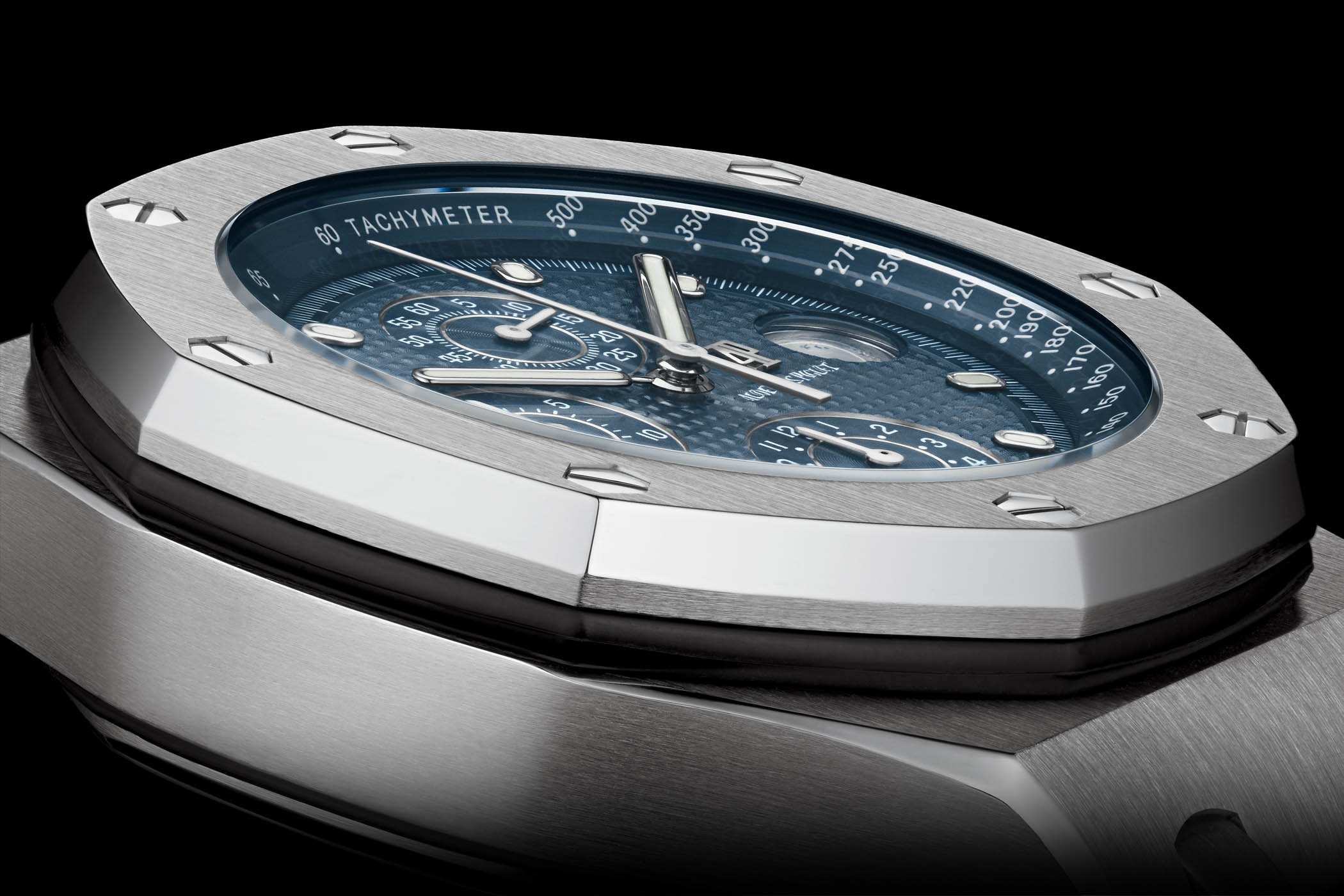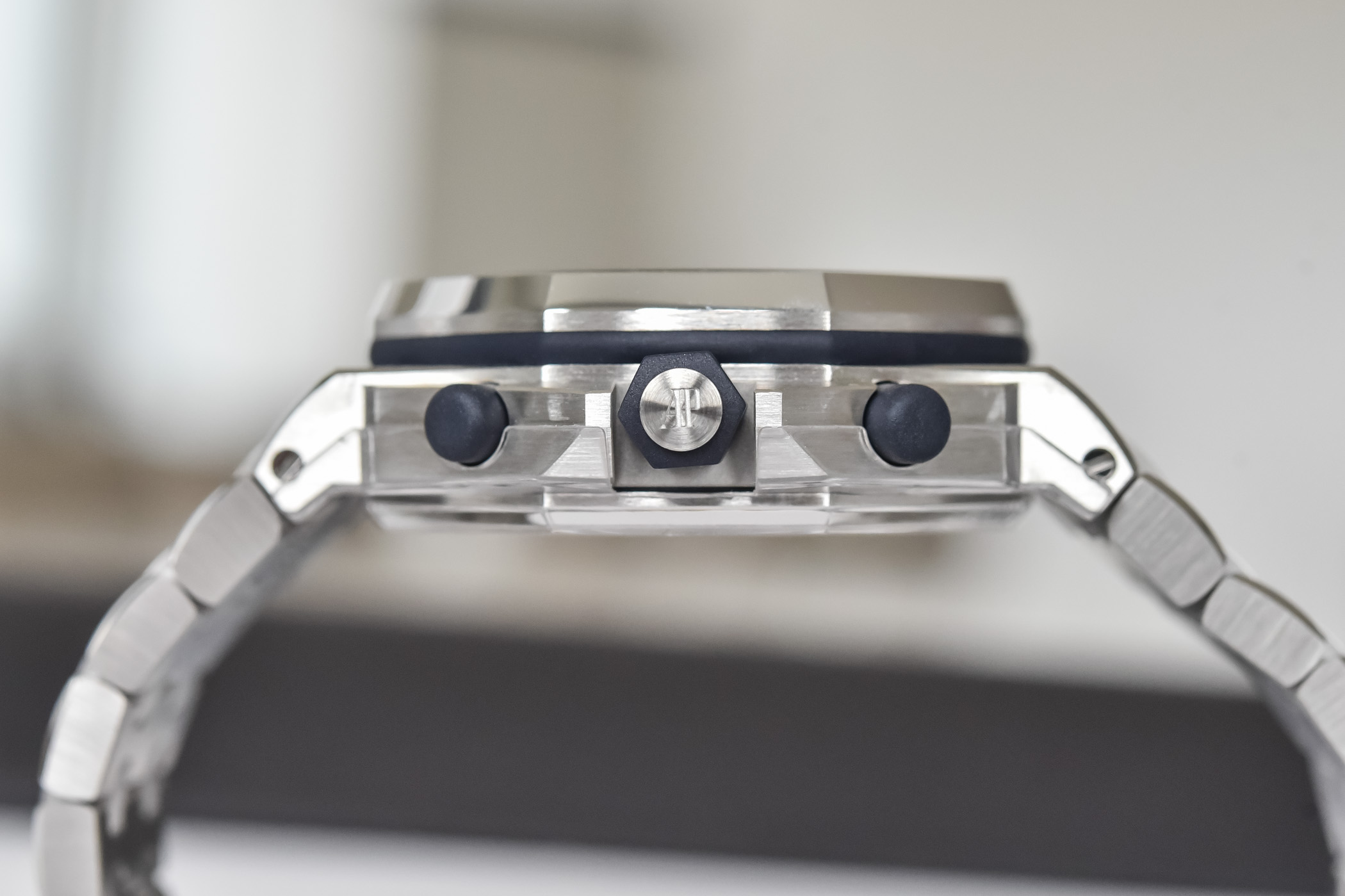The Beast is Back – The New Audemars Piguet Royal Oak Offshore Chronograph 26238ST
The return of one of the most powerful designs ever created by AP, in a form that recalls the early 1990s.

The Beast… This is the name watch enthusiasts gave to the Royal Oak Offshore when it was presented in 1993. If the classic Royal Oak of 1972 was already disruptive, the ROO was a shock, a true rupture, something unprecedented and provocative. But almost 30 years after its presentation, the Royal Oak Offshore has proven to be a finely tuned recipe and has since been derived in a multitude of versions. However, nothing can beat the iconic status of the original. We’ve seen a re-edition of this very watch in 2018 and, this year, Audemars Piguet brings a new version of its Royal Oak Offshore Chronograph that again pays tribute to the early years of the ROO. Also available in titanium and gold, we now take a closer look at the all-time classic steel-and-blue version of this 26238ST, which comes with noteworthy improvements, and isn’t limited anymore.
The 1993 Royal Oak Offshore
As always with watches paying tribute to a past model, a historical brief is necessary. First of all, one has to keep in mind the year 1972 and the Royal Oak. This watch, a whole new concept mixing sports watch credentials with high-end watchmaking refinement, as well as introducing the idea of an integrated design, was pretty provocative. In the early 1970s, the concept of a luxury watch, even for Audemars Piguet, was a small, thin, gold-encased watch, possibly with complications. Under the pen of Gerald Genta, the Royal Oak was born, and it created a whole new market segment, that of the luxury sports watch. Thin yet robust, angular, textured, luxurious in a young and fresh way, overly designed, built as a single element… It was disruptive but also successful.

A second move followed two decades later, still in the Royal Oak collection. In the early 1990s, the watchmaking industry was slowly recovering from the quartz crisis, and the watches produced were still quite shy and discreet. The comeback of the mechanical watch was just gathering momentum and the vast majority of high-end watches on the market – with the exception of a few sports watches – were still classically designed and relatively small in terms of diameter. Yet, in 1993, Audemars Piguet struck again by launching the Royal Oak Offshore.
What was this watch about? It was a testosterone-fed version of the Royal Oak in a 42mm case with chronograph, built with the words “massive” and “deconstructed” in mind. Some will recall how many collectors and insiders were disappointed by this novelty when it was unveiled at Baselworld 1993. Even Gerald Genta was shocked. Others, however, were amazed by this new concept designed by a young man named Emmanuel Gueit (22 years old back then). And the shock was so intense that the watch immediately became known as “The Beast”.
A massive watch back in the days, with a 42mm diameter and 15mm height, the Royal Oak Offshore 25721ST was angular, it was heavy and, in fact, even if all the iconic design elements of the Royal Oak were featured – the octagonal bezel, the eight hexagonal screws, the raised bezel, the tapisserie dial, the integrated bracelet, the overall shape of the case – the Offshore felt completely new and disruptive. It took the classic Royal Oak design and “deconstructed” it, by making the gasket between the case and the bezel highly visible, for instance. It also introduced new materials – in this case, rubber – mixed with metals. And later, the ROO would be dressed in gold, ceramic or even forged carbon.
The Comeback of “The Beast” with the new Royal Oak Offshore Chronograph
It’s not the first attempt of Audemars Piguet to bring back a modernized version of the classic 1993 Royal Oak Offshore, as in 2018, for the 25th anniversary of the model, the brand launched a limited edition watch – ref. 26237ST.OO.1000ST.01 – that was fairly faithful to the original in style and specifications. Although the original design has been kept alive for 2021, there are noticeable evolutions, the first being a new in-house movement, the second being that this watch is now offered as part of the permanent collection.
Looking at this new edition of the Royal Oak Offshore Selfwinding Chronograph 26238ST, fans of the concept won’t be surprised. It is, indeed, almost identical to the watch that inaugurated the ROO collection in 1993, at least visually, as some details have been updated, mostly on the back of the watch… Everything that made the original Royal Oak Offshore an emblematic model has been kept alive: the oversized, multi-step case; the classic Royal Oak elements; the combination of materials; the colours; the layout of the dial and its textures… But first impressions can be deceptive, as this new edition for 2021 has its fair share of new features.
The case is basically the same as the old ROO. With its diameter of 42mm and its height of 15.2mm, it retains approximately the same proportions. The overall design is also fairly close to the original model, with the highly raised octagonal bezel with its eight white gold screws, the exposed blue rubber gasket between the case and bezel, the blue rubber-clad pushers and screw-locked crown protected by pointy guards and the classic combination of vertically brushed surfaces enlightened by large, polished bevels on the sides of the bezel and the case. The case also retains the 100m water-resistance of the original. Except maybe for a few tenths of a millimetre here and there, and some more precise adjustment of the parts as well as a cleaner finishing (both thanks to modern production techniques), the case is very, very familiar.
As you’d expect, this new Audemars Piguet Royal Oak Offshore Selfwinding Chronograph has the same feeling on the wrist, even if the impression today, 28 years after its launch, is certainly less of a shock as we’ve come accustomed to oversized watches. Nevertheless, it still has an impactful design and a muscular presence on the wrist, combined with a substantial weight. Here photographed on Xavier’s 17.5cm wrist (apologies for not having adjusted the bracelet to the right length), no doubt that this new ROO still truly deserves its nickname “The Beast”. But keep in mind that this specific model is now one of the most “restrained” versions offered by Audemars Piguet in the Offshore collection… And whether you like the concept behind the ROO or not, it’s hard to argue with the visual impact created by this watch.
What truly connects this new edition of the Royal Oak Offshore Selfwinding Chronograph 26238ST with the original model of 1993 is its dial. For many years, we’ve indeed seen this watch offered with the so-called “Méga Tapisserie” pattern on the dial, with its large, embossed squares, while the original model featured a more refined “Petite Tapisserie” pattern obtained thanks to a guilloché process – almost identical to the 1972 Royal Oak Jumbo. And it’s now back for this new ROO Chronograph. And for this stainless edition, it also brings back the classic deep blue colour.
Just like when you compare a modern Royal Oak Jumbo 15202 to a vintage 5402, the “Petite Tapisserie” dial of the new Royal Oak Offshore Chronograph is far more impressive in terms of execution. Indeed, the guilloché process has been refined over the years, and the gaps between the squares are thinner, the texture has a much better definition, the pattern has more regularity, and the overall rendering is superbly sharp. But besides being more refined, there are many minor updates to this dial, such as a new applied AP logo or a lightly redesigned magnifying lens for the date window at 3 o’clock.
All the white markings are also better defined, but Audemars Piguet has kept the same shapes for the white gold applied markers and hands, which are still filled with Super-LumiNova. The real difference comes from the display. Sure, it retains the classic 6-9-12 layout for the sub-counters (the result of a modular chronograph in the past), but since the movement is now produced in-house, the position of these counters has changed, as the small seconds now sits at 6 o’clock, versus 12 o’clock in the past, where the hour register for the chronograph is positioned. The 30-minute counter retains its 9 o’clock position. Finally, and it’s an important detail, all the sub-counters are now equally sized and spaced. Gone is the weird position of the counter at 12 o’clock, which was closer from the central hands than the two other counters… Now with the new movement, everything is well aligned and proportioned, which will be appreciated by some, and others will somehow regret this oddity that was once found on the vintage model.
The reason behind this new layout is simple: this Royal Oak Offshore Chronograph is now equipped with the brand’s in-house, integrated chronograph. First introduced in Code 11.59, the calibre 44xx is a modern, technically advanced movement that initially came with a classic 3-6-9 layout. In order to retain the signature display, it had to be adapted for this watch. Other than that, the specifications are familiar. We’re talking about a self-winding chronograph movement with column wheel and vertical clutch, as well as a flyback function that allows resetting the timing session on the run by simply pressing the pusher at 4 o’clock once.
Known as calibre 4404, this large (32mm diameter) movement is visible through the caseback, including the rather spectacular reset mechanism with its three aligned hammers. The decoration includes straight and circular satin brushing, Geneva stripes, perlage on both sides and large polished chamfers. Running at a 4Hz frequency, it packs 70 hours of power reserve and is wound by a 22k gold oscillating weight.
Classically, this new Royal Oak Offshore Selfwinding Chronograph 26238ST is worn on an integrated RO bracelet, with all top surfaces (including the mid-links) brushed. The sides are nicely bevelled, and the bracelet is closed by a folding clasp. But if you look closely at the photo of the movement, you’ll notice that the reverse side of the links is equipped with pushers. Indeed, this new ROO comes with a clever interchangeability system, so you can change the bracelet for the blue rubber strap (also included in the box) without tools.
Availability & Price
The Audemars Piguet Royal Oak Offshore Selfwinding Chronograph in stainless steel – reference 26238ST.OO.2000ST.01 – is now available and is part of the permanent collection, just like the titanium and the gold versions presented simultaneously. It is priced at CHF 34,500 (excl. taxes) or EUR 40,100 (incl. taxes).
For more details, please visit www.audemarspiguet.com.


















2 responses
I can understand people wanting a ROO that looks like an original reference, but I still think the direction of the 15720ST & 26420IO w/Méga Tapisserie is more in line with the industrial vibe of the ROO.
I like this version of ROO, a sexy watch. It’ not too loud and not too stealth. Kind of every occasion watch.